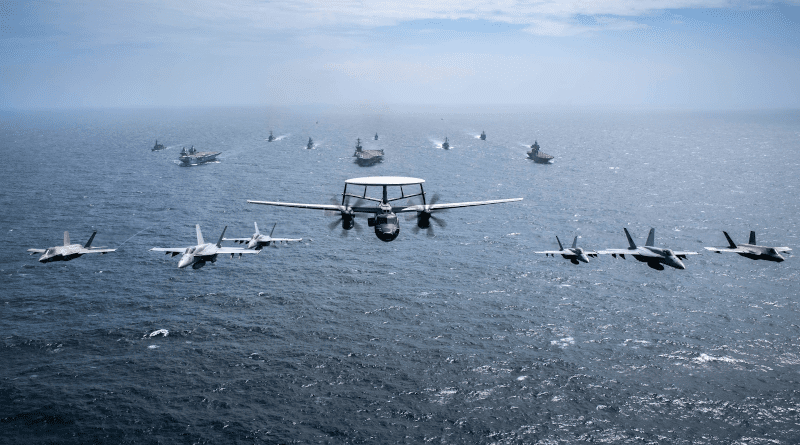Japan-Australia Reciprocal Access Agreement: The US Security Architecture In Indo-Pacific – OpEd
By Komal Khan
In January 2022, Japan and Australia entered into a bilateral ‘Reciprocal Access Agreement’ (JA-RAA) which is a defense and security pact that permits reciprocal access among Defense Forces of Australia and the Japanese Self-Defense Forces. This strategic partnership between Japan and Australia has been framed under their joint underlying goal that is security of their shared strategic interests aligned with the Indo-Pacific through an assertive foreign policy aimed at countering military assertiveness of China identified by both as the uncertainty that Japan and Australia have been facing in the Indo-Pacific.
The bilateral cooperation under the Reciprocal Access Agreement includes technological cooperation; military stationing and training; bilateral access to areas and facilities; and information exchange between Japan and Australia. The agreement legalizes allied support and extended military deployments under the extended network strategy to broaden their military reach and influence in counterbalance to China in the Indo-Pacific.
This bilateral strategic partnership depicts enactment of the US-led military order in the Indo-Pacific sustained by allied forces that provides for modernized military standings in the Indo-Pacific. Meeting the purpose, the agreement ensures reciprocal access to militaries into each other’s facilities and territories for carrying out naval inter-operability in the Indo Pacific. Moreover, the agreement legalizes their interoperability into international waters with the justification of bilateral security cooperation. Bilateral information exchange and facilitation under this agreement between both of the US allies is yet another major development that supplements the US info-exchange and surveillance networking in China’s neighbourhood.
The United States has opted for a strategic reassurance policy to secure the status-quo of the US-led world order which is witnessing a revision by China in the Indo-Pacific. Therefore, the JA-RAA presents an extension of the ‘United States Indo-Pacific Strategy’, the ‘free and open Indo-Pacific policy,’ and the ‘freedom of navigation’ doctrine of the United States to counter the emerging world order in the Indo-Pacific with the assistance of allies-cum-partnerships.
The agreement has strategic benefits for Australia and Japan. Primarily, it facilitates them individually by legalizing them as potential maritime powers in the region. As in the case of Australia; while it already holds naval projections in the South China Sea as well as in the Taiwan Strait, the reciprocal access to Australian forces in Japan further provides it with maritime extension in the East China Sea. For the United States’ allies, including Japan and Australia, Indo-Pacific Sea Lanes of Communication-(SLOCs) – are crucial for global trade. Similarly, these states are also claimants to the East-Asian maritime disputes over islands which necessitate such integrated deterrence as balance of power mechanisms against China. ‘2020 Defence Strategic Update’ of Australia signifies regional extension from the North-East Indian Ocean, into the South East Asia, to South-West Pacific, Papua, and New Guinea as Australia’s ‘immediate region,’ asserting ‘freedom of navigation’ and ‘free and open Indo-Pacific’ as order of the region.
Australia is foremost assertive in constructing the US Indo-Pacific security architecture by knitting strategic interoperability networks such as the ‘Exchange of Naval Nuclear Propulsion Information Agreement’ and the nuclear submarines purchase with the AUKUS; commissioning the HMAS Stalwart; and then the JA- RAA.
In the case of Japan, the JA-RAA presents the first status of forces agreement since 1960. The security pact indicates ‘security normalisation’ in Japan’s foreign policy for constructing ‘a security nexus’ in the Indo-Pcific this time via allying with equal and middle power in the region. Significant deployments by Japan under this Indo-Pacific security nexus are JS KAGA (DDH-184); JS MURASAME (DD-101); JS SHIRANU; and the ’Japan-Palau Goodwill Exercise; and the Japan-Vanuatu Goodwill Exercise.
The US-led security architecture holds responsibility for creating the security dilemma in the Indo-Pacific which may rightly be analysed as the cause of militarization in the region, be that the case of Taiwan and China, North and South Korea, or Pakistan and India. Notably, it was the growing US-Japan security partnership in the Asia-Pacific post World War II, with the occupation of Diaoyu (Senkaku) Islands and security of energy monopolies, that has been responded with China’s intense military buildup and, consequently, militarization of the South and East China Seas.
China’s security policy in the Asia Pacific asserts United States’ ineligibility to intervene within maritime and land issues of China aligned with the region based on the rationale that these issue fall under the domain of ‘internal matters’ of states in the Asia-Pacific; and secondly, based on the United States’ status of being till date a non-signatory to the United Nations Convention on the Law of the Seas. China is also creating an ASEAN security community through bi- and multilateral security-cum-economic agreements. Similarly, China is also constructing a matching complex interdependence structure for the US-led alliance-cum-partnerships; for instance, with Japan China is collaborating in cyber space and in artificial intelligence domains.
The interpretation of the US policy of strategic reassurance is basically strengthening of the allies and partners in East Asia. Comprehending the policy in his hearing to the Congress on ‘Maritime Security in the Indo-Pacific and the UN Convention on the Law of the Sea;’ Daniel Russel, former Assistant Secretary of State for East Asian and Pacific Affairs, answers that what the US is trying to do is to create an imminent response to China by reestablishing balance of power in the Indo-Pacific through modernized military presence, strengthened allies and partnerships.
Hence, the defense and strategic security architecture of the US under its policy of strategic assurance is being executed through regional interoperability mechanisms in networked security architectures to create an ‘integrated deterrence’ against China which is established as a shared threat to the interests of the US and its allies, and to the US-led world order in the Asia-Pacific. The JA-RAA is a significant development in this regard.
*Komal Khan, Research Officer, Strategic Vision Institute (SVI)

